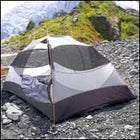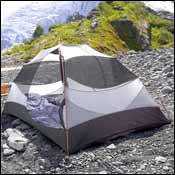Indeed, stuff doesn’t last forever—particularly when you head for the bargain basement. But I understand the impulse to do so when in your position. Gear can get expensive, and to fully outfit oneself from scratch can cost well over $1,000 if you’re really having to buy the whole gamut: pack, tent, sleeping bag, clothes, stove, cookware, and so on. It adds up. (To mitigate a few of these problems, check out .)
 Half Dome 2 HC
Half Dome 2 HC
I’ve found that investing in good-quality stuff pays off in the long run. This doesn’t mean you always have to buy the most expensive gear in its category, because companies such as L.L. Bean and REI offer excellent values in house-brand gear. I often recommend Bean’s Gore-Tex Mountain Guide XCR Parka ($279; www.llbean.com), and REI’s Half Dome 2 HC ($169; www.rei.com) is a fine three-season, two-person tent. Patagonia, Marmot, Mountain Hardwear, Sierra Designs, Mont-Bell, and similar companies offer good value, but the stuff does punch in at the higher price points. One positive trend: All these companies are more price-conscious than they were a few years back, and Marmot did the world a huge favor by introducing its PreCip line of rainwear, including a perfectly fine rain parka for $99 (www.marmot.com).
Now, after you invest, the question is: How to make it last? Wear and tear is inevitable. But you can control three things: dirt, sun, and mildew. Outdoor gear (somewhat ironically) hates dirt—dust and grit clog zippers, rub stitching, scrape off water-repellent coatings, and more. So don’t be afraid to toss stuff in the washing machine (tents and bags excepted; tents need to be hand-washed in a tub, bags laundered in a front-loading washer). It’ll thank you. Same for boots. Give them a scrubbing with a soft brush and water to keep sand and dirt out of the seams.
Sun is also a culprit, as it can greatly weaken fabrics. So try to pitch tents in shady spots, where possible, and always use the rainfly to help protect the tent canopy. Try not to sun-dry stuff you’ve washed, as well.
Lastly, mildew is just murder—it eats fabrics and leaves a rotten smell. So pack away your gear only when it’s dry, and only in a cool, dark, dry place. Also, try to store things such as tents and sleeping bags in breathable cotton bags, not plastic garbage sacks.
What can you expect for the life expectancy of gear? That’s a little hard to say, but assuming moderate use, and based on my experience:
That’s just an estimate. I have older stuff I still use, and of course some things get obsolete before they wear out.
For a treasure trove of the best gear your money can buy, check out ąú˛úłÔąĎşÚÁĎ‘s , including Gear of the Year, Killer Values, and almost a decade’s worth of gear reviewed, tested, and pounded by the experts. Also check out “Keep It Alive” advice for , , and .


